
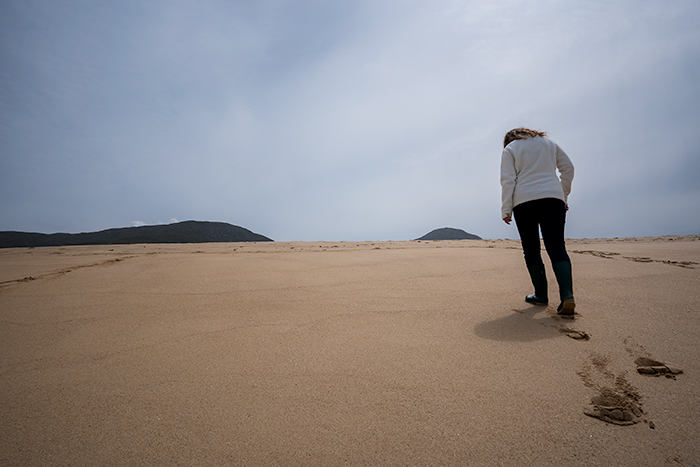 Are you familiar with the Lewis Chessmen? The strange-looking chess pieces that were found on the Isle of Lewis long, long ago? They’re not only world famous, but shrouded in mystery. Who found them? Where did they come from? Who carved them? And where were they going?
Are you familiar with the Lewis Chessmen? The strange-looking chess pieces that were found on the Isle of Lewis long, long ago? They’re not only world famous, but shrouded in mystery. Who found them? Where did they come from? Who carved them? And where were they going?
We can only speculate. We do know the general area where they were found, Uig Sands (Ardroil Beach), but not the details. So let’s imagine what could’ve happened…
Finding the Lewis Chessmen
Imagine walking along a desolate beach on a bleak sort of day. A strong wind, chilling your neck and whipping your hair in front of your face, causes your eyes to water, making the journey a little harder. You cinch your jacket tighter and walk through damp sand with head bent. Suddenly the toe of your shoe hits something hard. Blinking away tears, you crouch down to see what’s buried in the sand—
and pull out this strange little chess piece!

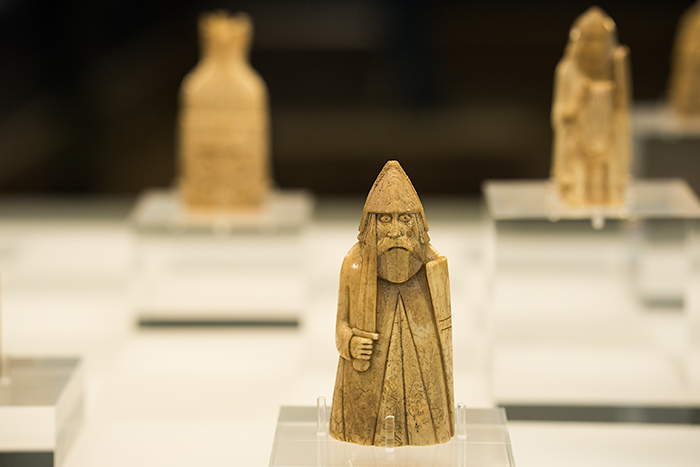
Berserker chess piece, Lewis Chessmen, Lews Museum, Isle of Lewis
Chess? Who’d be playing chess out here in the middle of nowhere, you wonder. You’re on a lonely stretch of sand on a barren coast that stretches for miles on the western shore of the Atlantic Ocean. There’s only a white farmhouse on a distant hill and no other visible structures in sight as far as your eye can see, on a remote island surrounded by sea 73 miles away from mainland Scotland in the far northwest. Remote? Yeah, that’s an understatement.

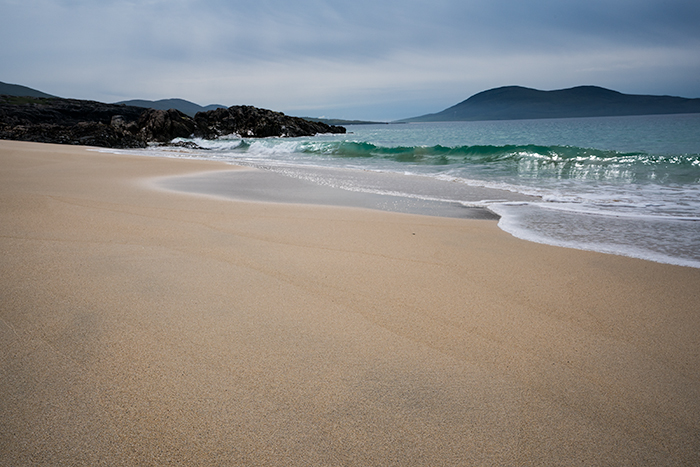
But somewhere around here, on Uig Sands, is where the famous Lewis Chessmen were found–Scotland’s most important archaeological find—dating from the 12th century. Nobody knows how they got here. Who found them. Or, exactly where.
What we do know is that this sea was a well recognized trade route for ships sailing from Scandinavia. And that Iceland and Scotland were central on this route.
Which legend do YOU think is true?
A sailor stole them…
Did a sailor really steal the Lewis Chessmen, jump ship and swim through icy waters and bury them for safekeeping? But in the end—couldn’t find them after digging in an escalated frenzy on this endless beach before his ship sailed on? Or, did he retrieve them safely only to get sidetracked with a darker story ending with ill-fate?
One story goes that before he could reclaim his treasure, he was found guilty of another crime and sentenced to death by hanging. On his death-bed, he confessed to the theft and whereabouts of the stolen goods. But due to shifting sands, and changing landmarks in the coastal landscape, the chess pieces couldn’t be found.
A local murdered the sailor for his loot…
Another version involves a local man murdering that sailor so that he could inherit the loot. But his murder was found out, and he was hanged.
A trade dealer buried them to avoid taxes…
Yet another legend involves a luxury trade dealer. Traveling along this route, he buried his stash in the sand to avoid paying taxes on landed goods with an intent to secretly retrieve it later. Then unfortunately lost the darned whereabouts thanks to shifting sands?
Shipwrecked at sea…
Or, what if the famed chessmen clutching each other inside a protective bag simply drifted ashore to Lewis Island when their ship capsized at sea?
Well, we may never know the real reason how they ended up here.
Hidden, helpless and forgotten, the Lewis Chessmen laid buried in sand. For over 600 years!!
But eventually, gale force winds and natural erosion blew their cover. And somewhere on this beach, the chessmen crested through the sand and made their presence known.

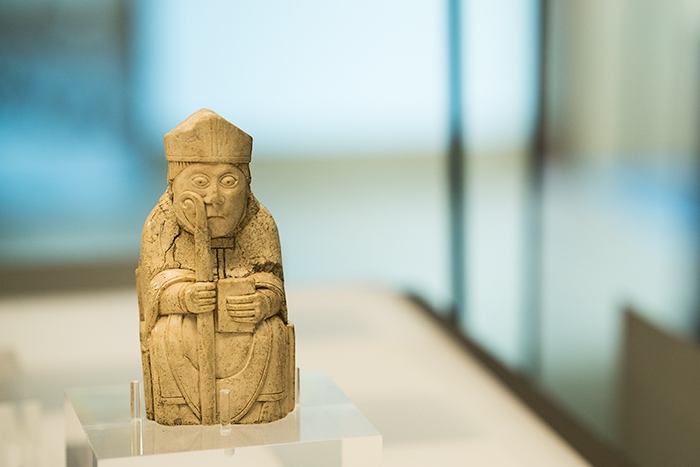
Bishop chess piece, Lews Museum
Who found the loot in the sand?
One account claims a farmer, Malcolm MacLeod of Pennydonald, was chasing his wayward cow across the sand dunes when he stubbed his toe on the case that contained the Lewis chessmen. Another account claims a fierce storm stirred sands with such force that it exposed a stone chamber buried 15 feet deep that held a collection of 78 chess pieces, 14 plain pieces and a buckle from a bag that carried them. Yet another account claims the chessmen were found 6 miles further south at Mèalasta beach and became the property of the ruling clan chief.
Malcolm Macleod sold the collection to a Captain Ryrie, who brought it to Edinburgh’s Society of Antiquities for Scotland. According to the meeting minutes, Ryrie expressed his doubts about the reliability of Malcolm’s story about how the chess pieces were found. But the Society of Antiquities was rather quick to publicly and proudly display them in Edinburgh on April 11, 1831.
A wooden statue of a King from the Lewis Chessmen stands at the edge of Uig (Norse word for ‘bay’) to signify the general place where the collection was found. (As you can see there is no sand here, but it’s close, just inland of Uig / Ardroil Beach.)

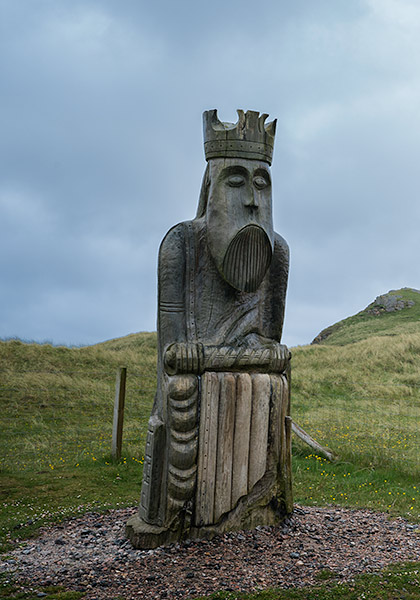
This wooden sculpture was carved by Stephen Hayward in 2006, commissioned by Uig Community Council with the co-operation of Ardroil Grazings Committee.
The Lewis Chessmen pieces
Carved from tusks of walrus ivory from Greenland, the chess pieces have a distinctive Nordic look. Some have comical expressions. (My favorite is the queen!)
Did you know? This chess set is unique from a game point of view. It was the first set to have Bishop chess pieces, and the first and only chess set that used Viking beserkers as the rook figures.
Berserkers, or Rooks: Lewis Chessmen Rooks are warriors, not towers. Four of the 12 Rooks are Beserkers, warriors ‘mad as wolves’ who were going berserk, biting their shields in battle frenzy with a crazed look in their bulging eyes. Instead of wearing wolf skins, they have long coats and carry expensive swords.
Bishops: None of the Lewis Chessmen Bishop pieces are armed. Instead, they hold a crozier, or shepherd’s crook, up to their cheek. Some of the 16 Bishops hold a small book in their other hand or raise their arm as if giving a blessing. They all wear the latest fashion of late Norse in pointed ecclesiastical hats. And they are taller than the other chess pieces–including the King, Queen and Rook. Plus they are carved from the highest quality of walrus ivory. Perhaps a nod to Bishop Pall who may have commissioned Margaret to create this set?
Kings: Sitting hunched over on matching thrones to the Queen, these 8 long curly haired figures are rather stoic, holding a sword laid across his knees. The King and Queen figures robed and crowned have the most detailed carvings. The expressions on the Kings vary. Some look stern, disappointed, tired or grumpy. Only the 2 younger Kings look eager for war.
Queens: Two earlier chess sets made in Italy and Spain (1100) both had a Queen. In the Lewis Chess sets, the 8 bejeweled Queens are all holding a hand to their faces, with a look of utter surprise, shock or horror radiating from their eyes. Hmmm. Wonder why?
Knights: These 15 chess pieces make the wide-eyed horses look like toys with short little legs that are shrinking from the weight of the soldiers. But back in the 12th century, horses were short. And not used in battle yet. They were merely transport. Knights rode horses to battle sites in Norway, Iceland, England and France. So their size did reflect the current time. Even today, riders on an Icelandic horse can look rather funny as they are still the size of a pony, being purebreds unchanged since the 12th century.
The collection of 78 Lewis Chessmen pieces is almost enough for 4 complete chess sets. (One knight, 4 rooks and 44 pawns are missing.) Individual chess pieces sorted by size, quality of carving, and distinctive facial features fall into 4 different groupings. Were they carved by one person? Or artisans working out of one shop?

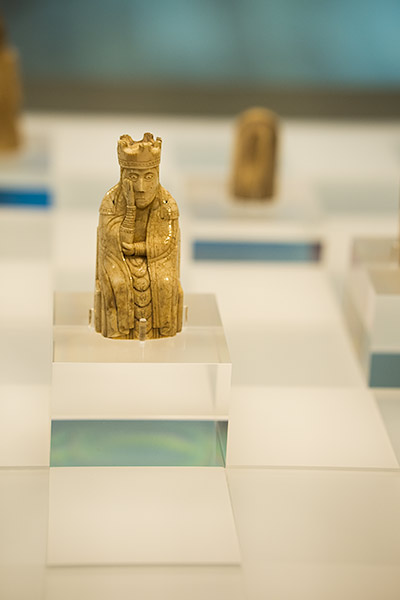
Queen, Lewis Chessmen, Lews Museum, Isle of Lewis
Where did the Lewis Chessmen originally come from?
Experts agree that the Lewis chessmen were carved between 1150-1200. They represent a Norse army with queens, Christian Bishops and Viking Rooks. Many believe they came form Norway– Trondheim to be exact. This was the end of the Viking Age when Norse were ruling the Isle of Lewis and the Outer Hebrides.
But Nancy Brown, author of Ivory Vikings, The Mystery of the most Famous Chessmen in the World and the Woman who Made Them, attributes the carving to master artisan Margaret the Adroit, from Skalholt, Iceland. In her book, Nancy creates compelling evidence that points to Margaret who was considered the most skillful carver of that time. Bishop Pall Jonsson of Skalholt hired her to carve ivory alter pieces for him and commissioned her to carve ivory gifts for important people he knew overseas. At the time, Iceland, existing to the west of Lewis Island, was central to the luxury trading route through the 13th century.
It was the first time a chess set included a Bishop. (Perhaps a nod to the person who commissioned them?) And the only time that a chess set used the strange-looking Rooks that were depicted as Beserkers. These Rook figures who are biting their shields in a battle frenzy represent the typical behavior of beserker warriors of the Norse god Odin in Icelandic sagas, written in the 13th century. And in 2011, another Beserker rook piece–this one made from fish bone– was uncovered in northern Iceland. It too dates from 12th century. Although half the size, the resemblance to the Lewis Chessmen Rook is uncanny. Coincidence? I think not.
Her book is a fascinating read, examining Viking history, medieval sagas, archaeology, art history and the history of board games in an attempt to solve the mysteries surrounding the Lewis Chessmen. And I’m jealous. Officials at the National Museum allowed her to hold 4 of the Lewis Chessmen in her bare hands and examine tiny details! You can buy her book here.
Where to see the Lewis Chessmen today
You can view the authentic chess pieces through glass in 3 different places. The pieces have been divided up between:
1) Lews Castle in Stornoway on the Isle of Lewis: 6 chess pieces.
2) National Museum of Scotland in Edinburgh: 11 chess pieces.
3) British Museum in London: 67 chess pieces plus the buckle and plain discs.


If you’re traveling to the Isle of Lewis, I highly recommend making the journey to Stornoway to see them in person. The Lews Museum inside the mock Tudor castle has fascinating displays about the clothing, history and culture of the people on this island, and the chess pieces are prominently displayed in a central glass box allowing tourists to clearly see the front and back of these carved masterpieces.

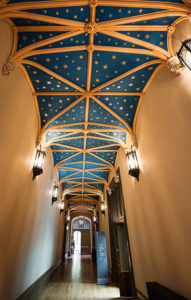
After visiting the museum, wander around–this is afterall the island’s only town. Buy Stornoway Black Pudding, smoked salmon, sweaters or Celtic jewelry handcrafted by locals.

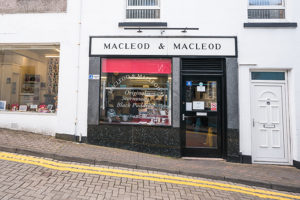
If you drive to Uig Sands (Ardroil Beach), about an hour away, make time to stop at the Uig Community Museum too. Open from April to October, Monday to Saturday 12noon-5pm, this wonderful little museum is run by community volunteers. Learn about the Clearances, fishing industry and learn about their lifestyle through the ages.
Hold replicas of the Lewis chessmen, and read the stories and legends that surround their mysterious existence. Support this local endeavor by purchasing items from the store and fresh baked items in the tea room too. The long bearded man manning the entrance was super friendly with a wealth of information that I wished we could’ve learned more from. (And had I known—groan—we surely wouldv’e asked him for directions to find the elusive Mangestra sea stacks on the beach!)

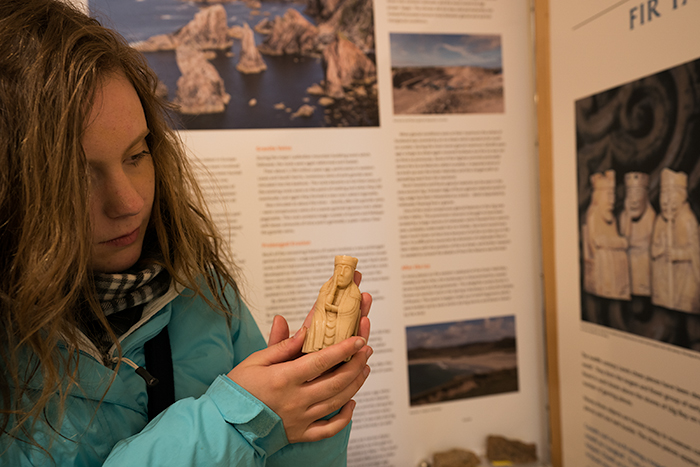
Uig Community Museum
Where else can you see the Lewis Chessmen?
Films and picture books. Maybe you’ve seen them in the Harry Potter and the Sorcerer’s Stone movie, Saga of Noggin the Nog on BBC, Ingmar Bergman’s movie Seventh Seal, historical drama Lion in Winter or even Disney’s Brave. They also illustrate book covers from children’s books to poetry, murder mysteries, or Viking history. But perhaps the most fitting book is The Chessman by Peter May, a murder mystery trilogy set on the Isle of Lewis. One of his characters in the The Chessmen, Whistler, lives in an old blackhouse on a hill overlooking Uig (Ardroil) beach. The surrounding hills and mountains are the setting for many scrapes between Fin and Whistler in the novel, and a nearby cave is the setting for a fatal scene.

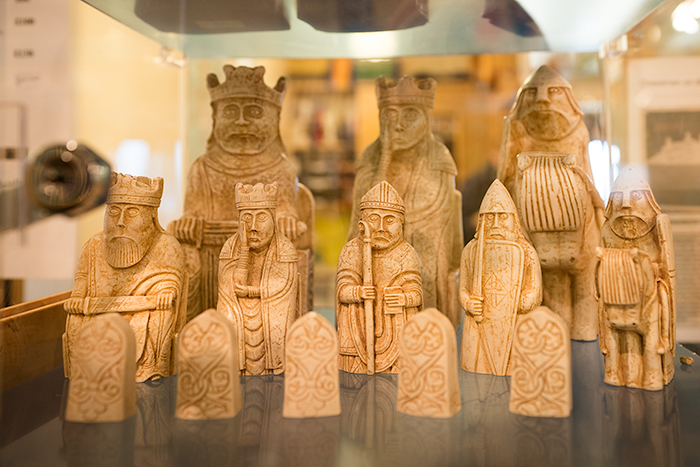
Lewis Chessmen replicas at the Uig Community Museum
Day Trip to Uig Sands (Ardroil Beach)
You will need a car. This is a remote area, located roughly in the middle of the island on the western coast, pretty far away from anywhere you’re likely staying. Driving distance from the 2 port towns on the island, both located on the opposite coast is 20 miles from Stornoway and 55 miles from Tarbert. BUT, allow an hour or more. You’ll follow B8011–a single track road– from the T intersection of A859 along the opposite coast that connects both towns.
A car park is located near the giant wooden statue (picture above). Mountains rise to the south of the famous beach. Get out and wander! You can walk for miles on the expansive sands. A great place to fly a kite, explore the shore, or practice naked yoga if you want. Cuz look around. You’re likely alone in this desolate place. Embrace the solitude of this beach and let it sink in— this is where someone like you once discovered the Lewis Chessmen peeking out of the sand. Incredible, isn’t it?.
Hungry?
Along the way, 4.5 miles before reaching Uig beach, Loch Croistean Cafe, serves tea, coffee, fresh baked goodies and light meals in a cozy former schoolroom. Wonderful place for lunch! Excellent soup, scones and sweet pastries. Open till 2pm.

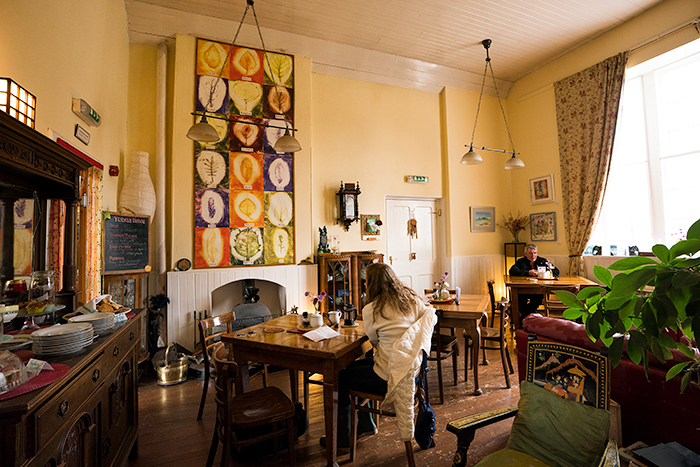
1.2 miles away: Another option for lunch or coffee/tea include the cafe at the Uig Community Centre & Museum or the Uig Community Petrol shop (vending machines and microwave). And one the few places to get gasoline on the island!
1 mile away from the beach is Uig Sands Restaurant. Although advertised open for dinner, it was closed during our visit–pre Covid. (This tended to happen to us fairly regularly all around the island. Restaurants and famed takeaways like North 40 were either closed with no explanation or completely out of business. In fact, we ended up eating at the only restaurant we could find open for dinner outside the 2 towns which was a tavern attached to the small inn, Doune Braes Hotel, west of the Callanish Stones.)
Closest Lodging choice:
Uig Lodge, built in 1876, is an impressive white structure that sits high on a hill overlooking the sands. Peter May used it as the fictional college in his TV drama series Machair. The stunning landscape of the turquoise colored water framed by white sands was also featured in The Chessmen.
There are a few B&B options around here too. Most are seasonal and include evening meals. Check out Uig options here.
Doune Braes Hotel, 10.5 miles north, is the closest hotel to Uig beach, where we ate dinner most nights.
Exploring Further Around Uig Sands:
Be forewarned. It’s not easy to find places on a map on this island! A ‘village’ depicted on a map might mean 3-5 houses and an art studio scattered across the moor. Forget about a GPS or popping into a gas station to ask for directions. Instead, think of it like a scavenger hunt…
We intended to find 3 places in the area: the hiking trail thru ‘Narnia’ to Norse watermills in Valtos (check), the bothy built by the Norgroves along a rocky coast (nope), and Mangersta beach to photograph the sea stacks at low tide (nope).
Valtos Beach, closest to Uig, was on a paved road further west and easy to find. By chance we found the hiking trail across the fence opposite the parking lot and spent an hour walking uphill in the rain to see a couple of stone piled water mills.
But the other two places remain a mystery.

.jpg)
This curvy, narrow one-lane road heading southwest of Uig toward Mangersta ended abruptly with gravel options leading either to a locked gate, someone’s long driveway or a long sketchy pot-holed gravel lane that looked like it would eat up our small rental car. There was no road signage for Mangersta. And nobody around to ask. There was a private art studio at the deadend–I believe the owners built the cliffside brothy–but it too was closed. Bummer. Obviously many get lost and bewildered here. A couple of artsy glass bottles with hands pointing in opposite directions playfully try to lighten the mood with the words “go back, this way, no, not that way…”
Not finding Mangersta was especially frustrating. Knowing that the timing of the approaching sunset and low incoming tide wouldv’e been the perfect combo for photographing the stunning sea stacks. Online pictures are amazing! Sadly we had to turn around on this shoulderless single track and head home. Couldn’t venture further and risk getting stuck out in this deserted moor in the dark. (Rather easy for tires to veer off these narrow roads and get stuck in the spongy boggy moor! And then what?)
My advice: don’t rely on maps or guidebooks or even blogs for directions. I’d devoured plenty. Instead seek out locals to ask along the way of reaching a specific area. It is surprisingly remote!!
But I digress. Back to the Lewis Chessmen…

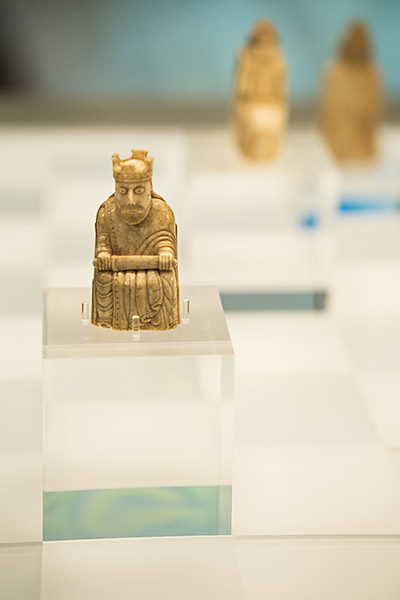
If you’re on the Isle of Lewis, you can see 6 authentic pieces of the original 12th century collection, like the one above. Just head to the Lews Castle Museum in Stornoway. Hours vary by season, so check out their website for details.
And if you’re game for a road trip to see the beach where they were found, plan an excursion to Uig. The road there is a paved singletrack and Uig is easy to find. Stop in at the Uig Community Center to see replicas of the Lewis Chessmen and read stories from the local’s perspective. (Check hours as they are currently closed due to Covid.) Buy a miniature chess set to take home, or order the one on Amazon made by the National Museum of Scotland. This is the set we bought. Cool, right? What better souvenir to remember our time on this island and Scotland’s most important archeological find?
~~~~~~~~~~~~~~~~~~~~~~~~~~~~~~~~~~~~~~~~~~~~~~~~~~~~~~~~~~~~~~~~~~~~~~~~~~~~~~~~~~~~~~~~~~~~~~~~
Pin it to save for later!

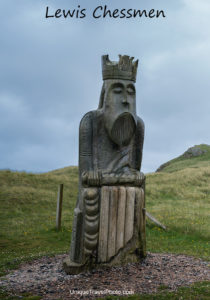


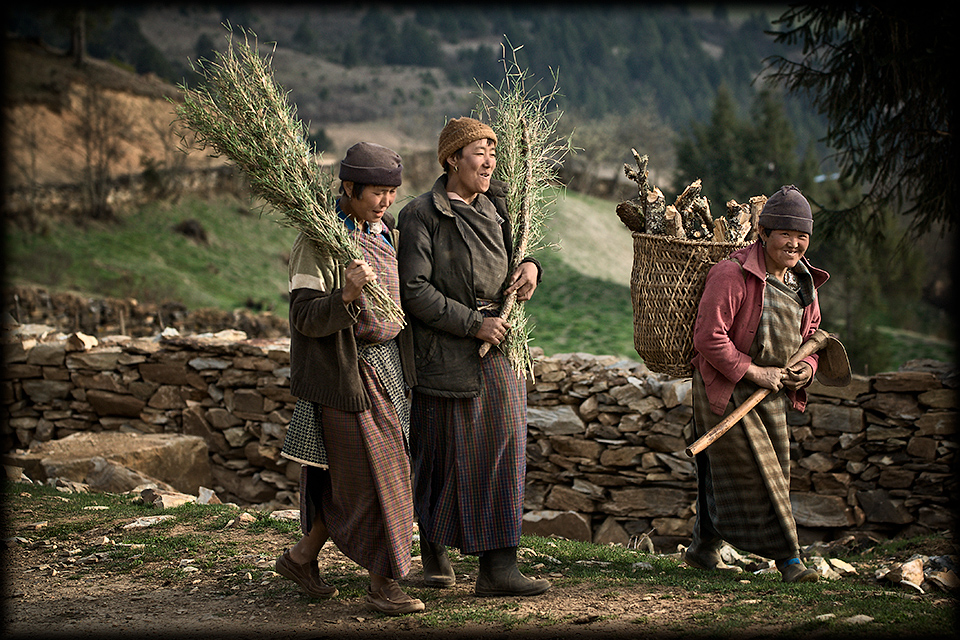
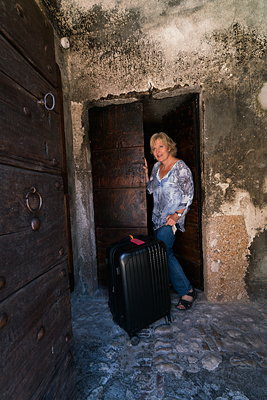
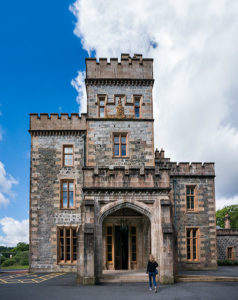
3 Roses in front of a Castle is my crest - Lady of the Lake tells a secret…
Ilse of the Skye
Reach out to the Sword and find a place where 13 gather….
Use frequencies to watch the show.
Rainbows for light’s
Sounds for frequencies.
Watch and see the sword pulled from the stone.